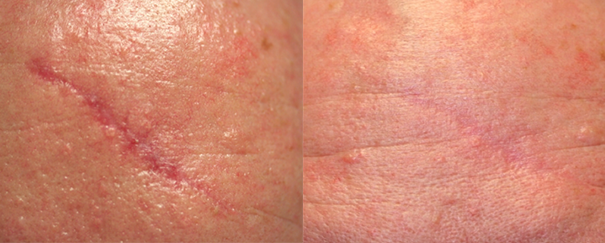DermSurgery Associates
6700 W. Loop South, Suite 500
Bellaire, TX 77401
Phone: (713) 791-9966
Monday–Friday: 8 a.m.–5 p.m.
Friday: 8 a.m.–4 p.m.
Scar Treatment
Whether from surgery or childhood injuries, most of us gather a collection of nicks and scars on our bodies through our lifetimes. These markings are typically small and fade over time, but some may increase in size or rest in noticeable areas. While it is impossible to make a scar disappear entirely, many innovative treatments can fade and improve their appearance. Our dermatologists have helped countless Greater Houston area patients minimize their scars and enjoy clear, blemish-free skin.
Before & After Scar Treatment

What causes scars?
Scars develop from trauma to the dermis of the skin. This trauma can be caused by any number of conditions such as acne, burns, abrasions, stretch marks from pregnancy, or even surgical incisions.
Scars are made up of cells called fibroblasts that produce collagen and connective tissue. A scar contains small blood vessels (capillaries) and blood flow, but there are no glands to produce oil or elasticity. Because of this, scar tissue sometimes becomes discolored, dry, and it can even begin to itch. It is important to let a wound heal naturally and leave the scab intact so it won’t form a larger mark. This is the best way to prevent discoloration or intense itching during the recovery process.
There are many different types of scars, such as acne marks created by deeper comedonal formations on the skin. Keloid scars, on the other hand, are an over-aggressive healing reaction by the body, and they can become very large and keep growing. Mild burn scars are a common nuisance that can contract the skin and cause pain over time. We can address all of these types of scars and more with a variety of scar treatments at our practice.
What treatments can I use to fade scars?
As mentioned earlier, scars develop as part of the healing process when there has been an injury. The treatment options depend on the size and depth of the scar, which will determine whether or not the treatment can be performed on an outpatient basis.
Many patients prefer in-office treatment instead of surgical intervention (which may be the only option depending on the size and type of the scar).
The most common treatment options in dermatology are:
PDT lasers to treat acne scars, using pulses of light to reduce the scarring.
Fraxel Dual laser resurfacing is a common method to ablate the scarred area and resurface to newer skin deeper beneath the dermis.
Microneedling is common for many types of scars, renewing the dermis by damaging the current scar and promoting collagen growth and smoother healing.
Dermal fillers may also be used in some cases. Fillers such as Restylane fill in deeper “hole” scarring.
Of course, there are other topical treatments used for newer, less erosive scarring.
How long after treatment will my scars begin to fade?
While complete scar removal is usually not possible, we can fade scars and diminish their appearance. How quickly they fade will depend on the depth of the scar and the type of treatment being used. Most results develop over the course of a few weeks as the skin around the scar tissue begins to heal. Nourishing creams and ointments can also be after treatment to better support the skin while it recovers.
Scars are a normal part of life, but you don’t have to feel self-conscious about their appearance. Request a consultation with one of our Greater Houston dermatologists to learn more about your scar removal treatment options.
Scar Treatment Locations Near You
High-quality skin care is never far away. Call a convenient location near you to request an appointment.
